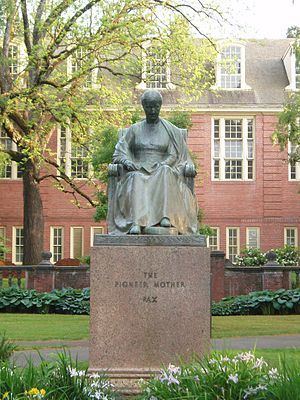Type Sculpture Created 1932 | Medium Bronze Year 1932 | |
 | ||
Subject An Oregon pioneer mother Similar The Pioneer, The Pioneer Mother M, Buffalo, Theodore Roosevelt - Rough Ri, Cascade Charley | ||
The Pioneer Mother is a sculpture located on the University of Oregon campus in Eugene, Oregon. Burt Barker donated the six-foot-tall bronze sculpture, created by artist Alexander Phimister Proctor, to the university. Barker's daughter, Barbara Barker, introduced the sculpture to a public gathering of hundreds on May 7, 1932, during Junior Week and Mother's Day festivities.
Contents
Creation and design
Pioneer Mother began with Barker, then a vice-president of the University of Oregon, who had the initial idea to represent the pioneer mothers on campus and financial resources to present this work as a gift to the state board of education. He commissioned Proctor to do the work in 1927, since Proctor had already created The Pioneer. For this sculpture, the model was Barker's own mother, Elvira Brown Barker, who migrated to Oregon across the Great Plains in 1847.
In design, The Pioneer Mother conveys the subject in later life, after the trials of the journey westward had long been completed. When Barker made the news of his gift public, he described what set this sculpture apart: "[o]thers have perpetuated the struggles of the pioneer mother; I want to perpetuate the peace which followed her struggles." The sculpture, placed atop a six-foot-tall base of pink granite, portrays a woman sitting at rest on a straight-backed chair, with a Bible upon her lap. The clear lines and massing of the base further enhance the suggestion of repose. Her journey, as represented in the bronze bas-relief panels on the west and east sides of the base, is over, and she is firmly rooted in her new home. Her style, as seen in her hair arrangement and cut of her dress, is simple, she is a depiction of all pioneer mothers in the twilight of their years.
Location
The sculpture was intentionally placed in a busy location on the University of Oregon campus. Barker stated in his address at her unveiling that "[i]t has been placed on the campus of the University of Oregon ... with the hope that so placed in the midst of the students and their activities, it may tell its story as a work of art and become a strong factor in implanting the love of the beautiful in the lives of the students as they go in and out before it."
As to her exact location, an Old Oregon article describes her placement thus:
"[h]er site was not chosen until a cardboard facsimile of the statue was placed at various positions on the campus. After the entire women's quadrangle was changed, the Mother was placed in the center, close enough to several paths so she can catch bits of University chatter."
She faces north, toward The Pioneer, a sculpture of a male pioneer, with Johnson Hall, the university's main administration building, between them. The sculptures are about one hundred yards apart. The primary sources consulted, however, give no indication that this was done with the intention they "face each other" as the popular notion today insists.
Recognizing the pioneer mothers
By the start of the twentieth century, the general public west of the Mississippi was beginning to recognize and even promote the acknowledgement of the efforts of the pioneer mothers. Headlines in Oregon read "Would Build Monument to the Pioneer Mother of Oregon: Declares Names of Wives and Mothers of the Pioneers Are Being Forgotten, When They Should Be Preserved and Revered" and "Heroic Mothers of Pioneer Days." This movement was begun to recognize the pivotal players in the settling of the western frontier.
